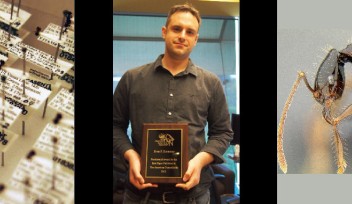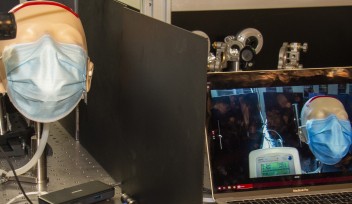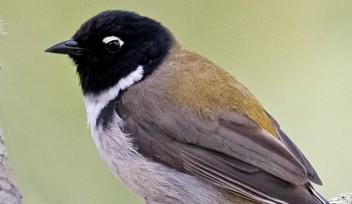Genetically Improved Crops Allow Habitat Expansion by Leafcutter Ants
Okinawa, Japan, February 24, 2011 — Hundreds of thousands of workers, on 24 hour shifts, cultivate food in enormous, underground factory farms, all over the northern part of South America, extending as far south as Argentina and penetrating northwards into Texas. Who are they? Leafcutter ants. Their society is one of the wonders of the world, with social groups numbering in the tens of millions, and each colony consuming as much plant matter as a cow. OIST scientist Dr. Alexander Mikheyev coauthored a paper published in the Proceedings of the National Academy of Sciences on February 22, which gives new evidence on: the behavior of leafcutter ants, reasons for the ant’s northern geographical limit and allows predictions for future expansion.
From each nest thousands of leafcutters set off to harvest freshly cut sections of leaves, which they transport home. The vegetable matter is carefully processed to create growing beds for the ants’ sole food, a fungus called Attamyces. Apart from the sap from the leaves the leafcutters ants live entirely on this fungus. To survive, they nurture and care for their crop with remarkable devotion.
One condition for a thriving crop of Attamyces fungus is correct temperature conditions. The vast majority of leafcutter species occur in the tropics, generally in rainforest, where temperature and humidity vary only moderately throughout the year. Growth rates of tropical Attamyces fungi are optimized around 25°C; growth stagnate below 20°C, and prolonged exposure to temperatures below 10°C can be lethal to tropical Attamyces.
"The growing range of parallels between human and ant agriculture, continues to amaze us," said Dr. Alexander Mikheyev, Independent New Investigator who heads the Ecology and Evolution Unit at OIST. "It will be interesting to understand the genetic changes underlying fungal cold-hardiness, and to see whether the remarkable adaptability of the fungi can be used to further improve human crops."
The research team found that the northernmost leafcutter ant Atta texana sustains fungi culture during winter temperatures that would destroy the cold-sensitive Attamyces of tropical leafcutter ants. Leafcutter ants possess an antennal sensitivity to temperature gradients that is far more acute than in any other insect, and this sensitivity enables leafcutter workers to rapidly assess temperature gradients. The team showed that the ants at the northernmost limits of the leafcutter distribution normally use cultivation chambers close to the surface but as the temperature drops in Winter they collapse these chambers and relocate their precious crop to much deeper chambers, more than 3 meters below the surface.
The garden relocation behavior improves growth conditions for gardens at northern latitudes, but still exposes the cultivated fungi to significantly colder temperatures (around 10-15°C) than the warm soil temperatures experienced by tropical leafcutter fungi. By testing over a 100 samples of Attamyces from different geographical sources the team was able to infer the existence of genetic changes that allowed the fungal cultivars to tolerate much colder conditions at the limits of their range. Like human agriculture, the evolution of agriculture in ants has made leafcutters extremely successful. The pole-ward spread of humans and of leaf-cutting ants has been limited only the by cold-tolerance of our crops, which come from tropical or temperate stock. However, this study shows that the geographical range of agriculture can be to some extent extended by selection for the hardiness of cultivars.
Article information:
1. Journal Name: The Proceedings of the National Academy of Sciences
2. Article Title: Evolution of cold-tolerant fungal symbionts permits winter fungiculture by leafcutter ants at the northern frontier of a tropical ant–fungus symbiosis
3. Authors: Ulrich G. Muellera,b, Alexander S. Mikheyeva,c, Eunki Honga, Ruchira Sena, Dan L. Warrena, Scott E. Solomona,d, Heather D. Ishaka, Mike Coopera, Jessica L. Millera, Kimberly A. Shaffere,a, Thomas E. Juengera,b
a Section of Integrative Biology, University of Texas at Austin, Austin, TX 78712, USA.
b Institute for Cellular & Molecular Biology, University of Texas at Austin, Austin, TX 78712, USA
c Okinawa Institute of Science & Technology, 1919-1 Tancha, Onna-son, Kunigami, Okinawa 904-0412, Japan.
d Department of Ecology & Evolutionary Biology, Rice University,
Houston, TX 77005, USA.
e School of Life Sciences, Arizona State University, Tempe, AZ 85287, USA.
About OIST
The Okinawa Institute of Science and Technology (OIST) is a new graduate University. The purpose of OIST is to conduct world-class research and education in science and technology in Okinawa, to contribute to the self-sustaining development of Okinawa and to the advancement of science and technology worldwide. OIST currently has 27 research units (more than 170 researchers) carrying out multi-disciplinary research in neuroscience, molecular sciences, mathematical and computational biology, and environmental science. It has launched a program of international courses and workshops that have already achieved worldwide recognition. An application for an accreditation as Graduate University by the Japanese Minister of Education, Culture, Sports, Science and Technology is scheduled for March 2011.














